ISSN: 2511-7602
Journal for Art Market Studies
ISSN: 2511-7602
Journal for Art Market Studies
Eline van den Berg
The Princessehof Museum in Leeuwarden, the Netherlands, was founded in 1917 by the notary Nanne Ottema. He had a particular interest in Chinese ceramics and acquired an extensive collection on which he also published several books. Even though Ottema never travelled to Asia, a major part of his collection was gathered there by other individuals. In particular the collections assembled during the early twentieth century in Indonesia (the former Dutch East Indies) by Anne Tjibbes van der Meulen (1862-1934) and Reinier Verbeek (1841-1926) form an important part of the Princessehof collection. The former is particularly known for its collection of storage jars (also known as martaban) and the latter for its collection of Zhanghzou ware. These ceramics had often for centuries been important heirloom pieces for local families, while other pieces were found during excavations. One notable example are several Tang dynasty storage jars found in the vicinity of the Borobudur. This article will discuss the formation of the Asian ceramics collection at the Princessehof by looking at these two collectors and highlighting the provenance of several exemplary objects.
In 1935 Nanne Ottema, founder of the Princessehof National Museum of Ceramics, visited an antique dealer on the Delftsche Vaart in Rotterdam, an area that has now disappeared due to the bombardment in 1940 of Rotterdam during World War II.1 The dealer had a group of Chinese porcelain pieces which had been sent to him by his brother working in the Sangir Island, Indonesia. Ottema’s eye was attracted to one piece in particular: a large blue-and-white vase with a design of a fierce three-clawed dragon (fig. 1). In his publication on Chinese ceramics he writes about this moment: “As the other specimens were off colour and of no special interest, I only bought this one, which may be dated at least Hsüan-Té, like many related specimens in the Top-Kapi Museum, Constantinople”.2
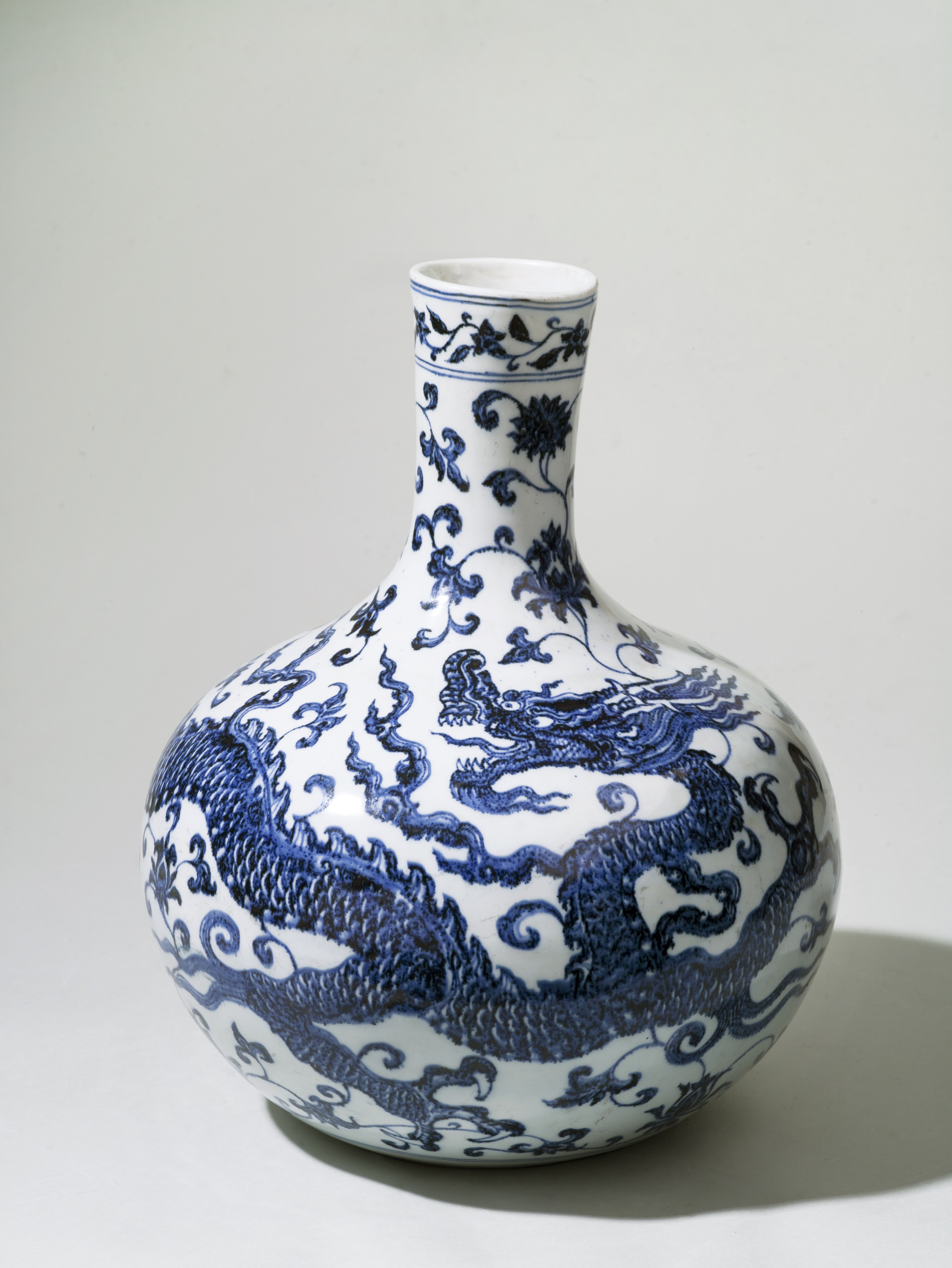
Fig.1: Blue-and-white vase with a design of a three-clawed dragon, Jingdezhen (China), Yongle period (1403-1424), porcelain and cobalt blue pigment under glaze, h. 43 cm / w. 33 cm
Leeuwarden, Princessehof National Museum of Ceramics, NO 01109 (on loan from Ottema Kingma Foundation)
By then Ottema had already been for many years an avid collector of Asian ceramics and his trained eye did not let him down. Even today this dragon vase is one of the top pieces from the Princessehof collection showing the great quality of Chinese blue-and-white porcelain produced during the early years of the Ming dynasty (1398-1644) in the imperial kilns of Jingdezhen. Of particular interest however is the provenance of this piece. As mentioned, the vase had been taken from Indonesia, which at that point was still known as the Dutch East Indies. Like many museums (and private collections) of Asian art and material culture that were built up in the Netherlands, the Princessehof also has a strong link with this former colony. Especially in recent years the provenance of such public collections has become the focus of attention in the Netherlands. In 2019 the Dutch minister of Education, Research and Science made resources available for the start of a research project on this topic, which is still ongoing.3 Even though the Princessehof is currently not (yet) involved in this project, it does realise the importance of looking at the origins of its collection from Indonesia. Previous publications about the museum and its collection do mention this provenance, but it is generally not a focus of the articles. Ottema himself never travelled to Indonesia, however, a major part of the Chinese ceramics acquired by him came from this region.4 He developed an extensive network of friends and acquaintances who also collected Asian ceramics. Several of them spent part of their lives in Indonesia, which often marked the start of their interest in this material.
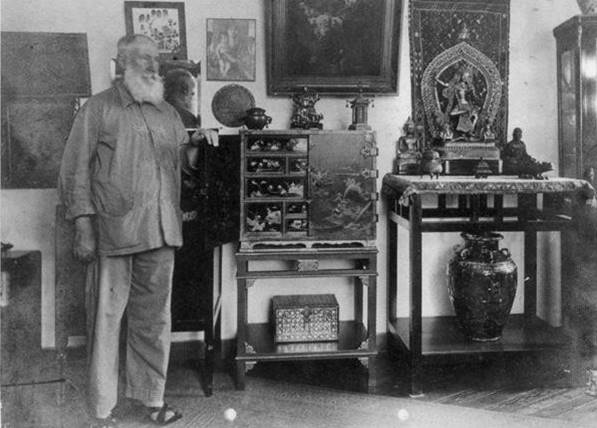
Fig. 2: Anne Tjibbes van der Meulen in his museum in Bergum, circa 1905-1910
Princessehof National Museum of Ceramics
Two men in particular should be mentioned here: Anne Tjibbes van der Meulen (1862-1934) and Reinier Dirk Verbeek (1841-1926) (fig. 2-3). Both developed a close friendship with Ottema and decided to donate their collections to the Princessehof. Though living and collecting in roughly the same period, their motivation in acquiring their pieces seems rather different. However, they have in common that early on they seemed to realise the potential of the Dutch East Indies as a source for collecting early types of Asian – and in particular Chinese – ceramics. Their respective collections serve as an example in this article to illustrate how Asian ceramics were acquired during the colonial period before ending up in a Dutch museum like the Princessehof. It will be argued that these cultural biographies of objects form an essential part of the museum’s history about which visitors should receive information. Before doing so, this article will first look briefly at what prompted the collecting activities of the Dutch in Indonesia and then discuss the formation of the collections of these two specific collectors.5
From the moment the Dutch East India Company (VOC) entered the Asian trade market, exotic objects were actively collected by various individuals involved in travelling to this region. These included coconut, shells, corals, precious stones and other (until then) rarities that were often displayed in cabinets of curiosities. Interest in and study of local cultures of those regions was less of a concern, since the main priority of the Dutch was the economic value of products and natural resources from those areas. This seemed to change in the course of the eighteenth century, as demonstrated for example by the establishment of the Batavia Society for Arts and Sciences in 1777.6 The society was led by VOC Officer Jacob C.M. Radermacher (1741-1783). His house became a place to store collected artefacts, and in 1779 it was named Batavian Museum.7 The focus however was more on nature and science and less on local material culture. During the late eighteenth and early nineteenth centuries activities were also complicated by political turmoil in the Netherlands, which also affected the stronghold of its Southeast Asian territory. A marked change was caused by the publication of the book History of Java in 1817 by Thomas Stamford Raffles that also covered his discovery of the Borobudur. Raffles was Lieutenant Governor of Java during British rule from 1811 to 1815. While in Java he undertook several trips during which he obtained many objects found locally. In addition he was appointed director of the Batavia Society for Arts and Sciences, and under his stewardship the collection of the Batavian Museum was expanded and more systematically studied. As pointed out by Tular Sudarmadi, Raffles’ studies marked the start of the Westernisation of the East Indies cultural heritage. Ancient Javanese historical sites like Borubudur and Pramaban were considered part of the Indian cultural development and therefore indirectly linked with Greek (and therefore Western) art traditions. Probably as a result, the Dutch upper class in Indonesia during this period became increasingly convinced that it was their responsibility to preserve and conserve local history, art and monuments. They believed that without their efforts these would otherwise disappear and that there was a need to civilise the indigenous people. This provided justification for the “protection” of ancient relics, and the recently established museums in The Netherlands and Indonesia were considered better suited to preserve these objects than local people.8
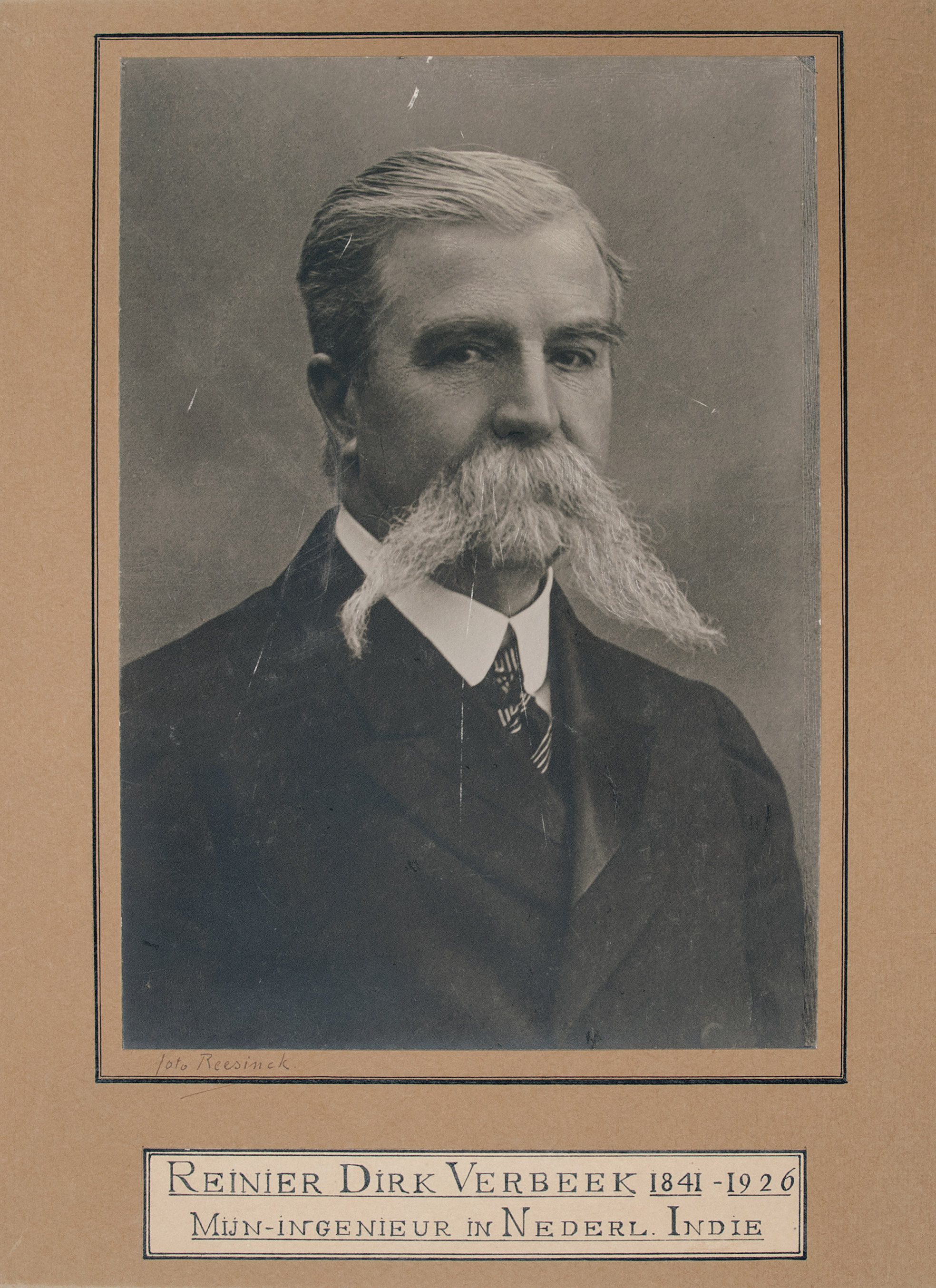
Fig. 3: Reinier D. Verbeek, 1929
Princessehof National Museum of Ceramics
During the nineteenth century this led to increasing interest by the Dutch, both based in Indonesia and in the homeland, in collecting objects that had been part of local communities for centuries. In addition, these collections were now also entering the public domain by being displayed in museums, as opopsed to being seen by a closed circle of people in private collections. The donation of objects to a museum by collectors also enhanced the status of these private individuals and likely created further stimuli for such activities amongst the upper classes. As has been pointed out by several scholars like Carolien A. Drieënhuizen and Pieter ter Keurs, collecting is never neutral. Certainly during the colonial period it was political and power relations between the colonisers and the colonised played a role.9 Many of the objects owned by local families were considered sacred heirloom pieces (pusaka) with spiritual and symbolic meaning linking them to ancestors. The ownership of pusaka by various local leaders also served as a justification of their power. This was also understood by the Dutch, so that during military conflicts during the colonial period many of those objects were intentionally seized as war booty to be presented at museums, stripping those leaders of their symbolic power.10 This largely concerned more “valuable” materials such as weapons (krisses), jewels and other precious metals. In addition to these events, local antique dealers were also taking advantage of the increased interest by the Dutch elite in these objects.11 They knew the local communities and were able to buy numerous heirlooms from them, including ceramics from China, Japan, Thailand and Vietnam. These pieces had ended up in Indonesia through maritime networks that had existed in Asia for centuries.12 In particular Chinese porcelain and stoneware had from at least the ninth century been a highly valued commodity in Southeast Asia. The remains of shipwrecks found in Indonesian waters that contain Asian ceramics attest to the enormous scale of this trade.13
Documents from the nineteenth century generally do not indicate what convinced local people to sell century-old heirlooms which were regarded as important, even spiritual objects. Even though there was increasing interest from Dutch collectors in these pieces, the question remains why a family would sell such a valuable and emotionally charged object. Was it dire economic conditions that made them decide to do so? Drieënhuizen indeed points in this direction. She remarks that consecutive wars had left part of the local population in impoverished conditions due to diseases such as cholera and failed harvests because the land had been destroyed or burnt by fighting troops.14 The poverty of part of the local population is also mentioned by several contemporary writers who had spent time in Indonesia during the late nineteenth and early twentieth century.15 Another slightly later observation comes from Egbert W. van Orsoy de Flines (1886-1964), who amassed a vast collection of Asian ceramics in Indonesia during the early twentieth century, which he donated to the Batavian Society in 1932.16 With regard to large storage jars (martaban17) he states that many of the remote villages where these pieces had long remained were at the time emerging from isolation. Together with the introduction of schools this had in some places led to a diminished belief in the objects’ magical powers.18 A reduction in meaning attached to them and increasing interest from Europeans in these objects may also partially explain why local people were willing to sell these pieces. Other ways that objects entered the market were through land farming, mining, and the construction of railroads and other infrastructure that intensified in this period.19 During such projects workers quite regularly stumbled upon ceramics and other objects that had been buried underground for centuries, which is also mentioned by Ottema with regard to the formation of the Van der Meulen collection of early Chinese ceramics.20 In addition, historical sites and the first attempts at archaeological excavations proved to be fruitful places to “collect” objects.21 Another important development in the formation of these collections was the opening of the Suez Canal in 1867. It created a much faster and safer route to the Dutch East Indies, making it easier for people to travel and for their collections to be shipped home. This is also evident from looking at museum collections in the Netherlands gathered in the Dutch colony. The majority of pieces collected in Indonesia entered these museums in the late nineteenth and early twentieth centuries; this also applies to the Princessehof.22
The largest external contribution to the Princessehof was the collection gathered by Anne Tjibbes van der Meulen.23 Born in Bergum, Friesland, and trained as a teacher he moved to Indonesia where from 1889 to 1892 he was appointed as a drawing teacher for the colonial administration at Semarang. Bad health forced him to return home, but once recovered he began to travel in Europe, visiting many museums which sparked his interest in art and material culture. In 1895 he returned to Indonesia, and during this period he began collecting. He spent time in Batavia, Magelang and Soerabaia and developed a friendship with Mas Boediardjo, who became like a teacher to him, introducing him to the arts and culture of the region. In 1905 he returned again to the Netherlands, bringing his collection with him. One year later on 28 May 1906 he opened the “Indische Museum” in his hometown of Bergum. It soon attracted considerably interest, including by Ottema who by then had also assembled a significant collection of Asian ceramics.24 Running a museum however turned out to be quite a financial burden for Van der Meulen and in 1910 he began selling some of his pieces to raise funds. This prompted concern from Ottema, who expressed the view that it would be a shame for his collection to disappear. They came to an agreement, and in June 1910 Van der Meulen donated his entire collection to Ottema with the proviso that Van der Meulen would receive an annuity of 400 guilders for life and would travel in search of new objects to add to Ottema’s collection. In 1917 Ottema opened the “Museum of Indonesian and Chinese Art” at the Princessehof in Leeuwarden. In the meantime Van der Meulen travelled to various places in Europe and from 1912 to 1920 spent more time in Indonesia to acquire Chinese ceramics at Ottema’s request. In 1921 he returned to the Netherlands and settled in The Hague for some time before going to Egypt where he lived for several years at the Luna Hotel in Cairo. He acquired more pieces for Ottema, but also collected glass, beads, metalwork and other objects that were displayed in his room, which soon started to look like a small museum.25 The last eight years of his life he spent in Egypt where he died suddenly on 10 January 1934.
During his life Van der Meulen categorised his collection in several catalogues, to which the museum database often refers. Unfortunately the original manuscripts have been lost since the 1970/80’s, making it impossible to research more detailed information. He published a small book on his collection; however this only provides limited insight into where and from whom he acquired objects. The only name mentioned is the dealer The Hong Twan who gifted a bronze figure of a Guanyin to him.26 He also had an extensive correspondence with Ottema during this travels, which provides slightly more detailed information on the pieces he acquired from the period when he started working for Ottema.
A major part of the Chinese ceramics in the Van der Meulen collection gathered in Indonesia dates to the Ming and Qing dynasty, consisting of vases, jars, cups, bowls, plates and teapots for everyday use. Many of these pieces were likely from the large Chinese communities living in Indonesia. Several of those ceramics, now part of the Princessehof collection, were listed in the sales catalogue on ritual porcelain. This catalogue must have been made by Van der Meulen in 1910 when he was about to sell his collection. The fact that he categorises them as ritual porcelain, gives an indication of their former use and indeed several of these ceramics are incense burners and figures of deities. Next to these later pieces, the collection also contains Chinese ceramics dating to the Tang and Song period, including storage jars. These older objects were treasured by the local communities in Indonesia, as is also reported in a publication in Elsevier magazine of 1910 by Johan E. Jasper (1874-1945), Control Officer for Internal Affairs at Soerabaja.27 He remarked how antiquarians were able to buy considerable quantities of this porcelain in remote villages. In addition he mentions that in the Celebes this type of ceramics was found in graves and that martaban jars were held in high esteem by the Dayak population on Borneo. On Java people attached spiritual power to early Chinese ceramics. They were kept as relics and believed to contain healing powers when used as drinking vessels.28 A Tang ewer (fig. 4) from Van der Meulen’s collection may have served in this way. According to the museum archives it was excavated at the Merbabu volcano on Central Java. It does not mention in which context, but Van Orsoy de Flines provides a probable answer, noting that these ewers were found exclusively in places which had been centres of religious worship on Central, and East Java, and Bali.29
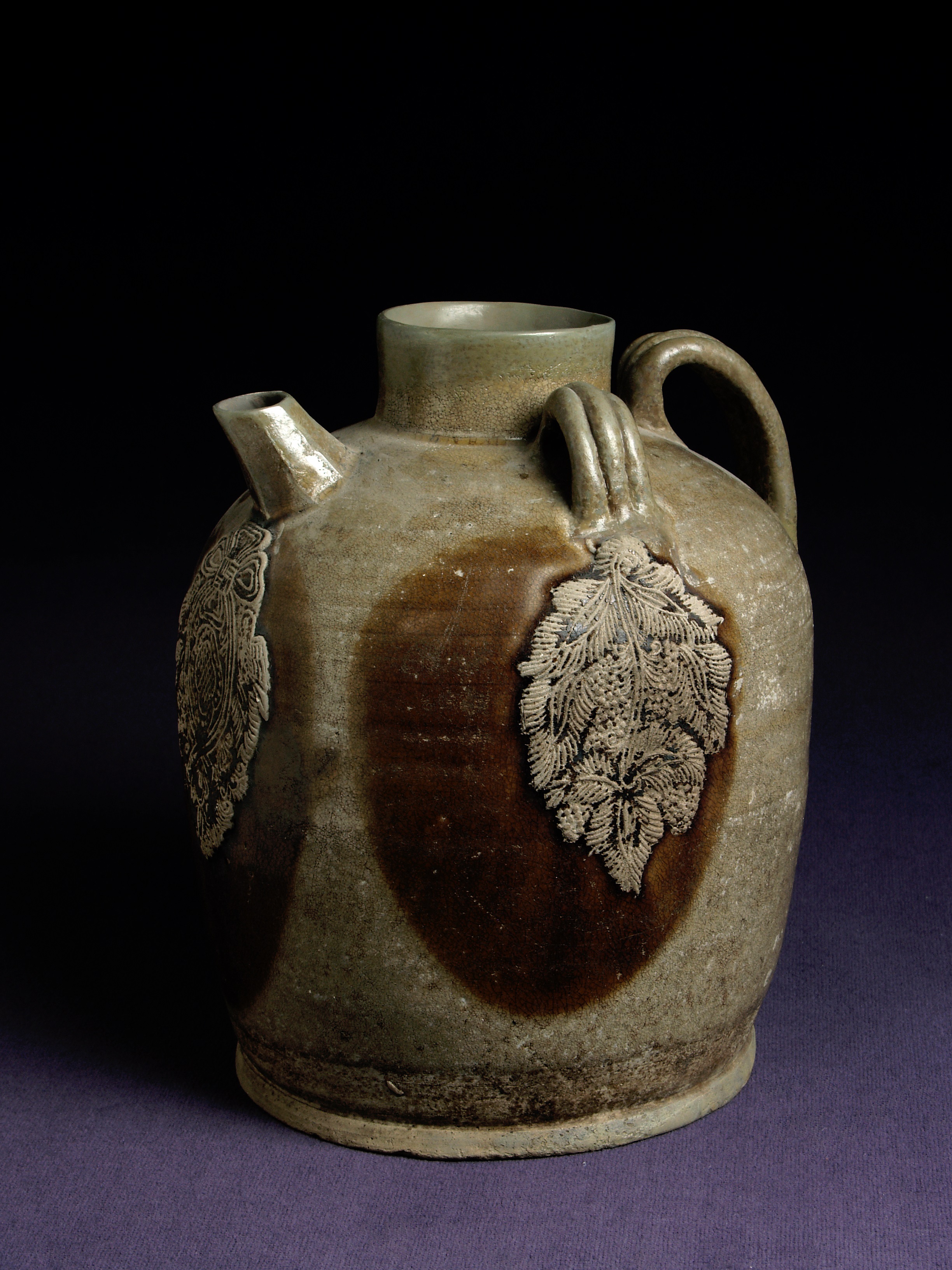
Fig. 4: Ewer with applied decoration, Tongguan kilns, Hunan (China), Tang dynasty (618-907), stoneware painted with green and brown under glaze, h. 19.8 cm / d. 16.5 cm
Leeuwarden, Princessehof National Museum of Ceramics, GAM 0633
Princessehof National Museum of Ceramics
Of particular interest are storage jars from various periods produced in Guangdong province that were exported to Southeast Asia in large numbers. Originally these were probably used as containers to store food and liquids like alcohol and water. But as mentioned previously they gained spiritual meaning and became linked to ancestors of the local population. Van Orsoy de Flines notes how such pots were still found in West-Borneo during his time containing human remains or ashes from cremation.30 There were several legends about the origin of these pots. For example, the Dayaks of Borneo believed that they came from Central Java and were produced from the earth of the Merbabu during the Hindu period.31 Notably, several of Van der Meulen’s pots of this type dating to the Tang and Song dynasties were actually found in this area (fig. 5). Ottema mentions that in 1930 he was able to acquire similar jars from the collector Mr. H. Groeneveld who had bought them in the same region from local people on the hills of the Merbabu. They told Groeneveld that some fifteen years ago another Dutch man had been interested in these kinds of jars and had purchased them. According to Ottema this must have been Van der Meulen.32
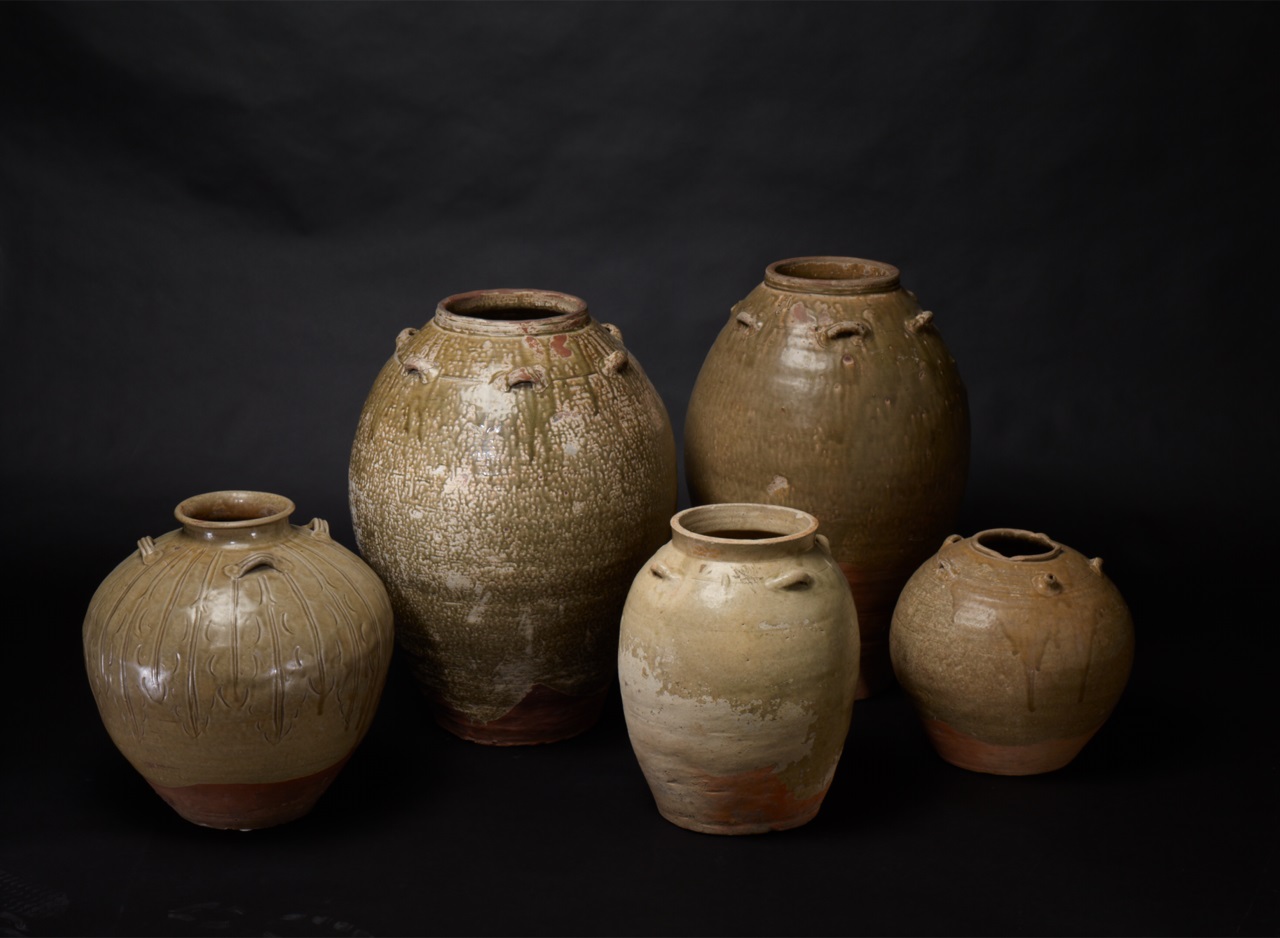
Fig. 5: Various storage jars from the Princessehof collection. According to Van der Meulen, the jar in the middle was excavated in the vicinity of the Borobudur.
Princessehof National Museum of Ceramics, photo: Erik en Petra Hesmerg
Reinier Verbeek was a civil engineer, who left for Indonesia in 1868, where he soon married Elisabeth Cécile van Hogendorp (1849-1935), having studied in Belgium and Germany. He was stationed in Sumatra at Fort de Kock and later at Painan to work in mining coal, gold and silver in the area.33 In 1877 he was sent to Oloe Ajer near the Ombilin River to do research on the mining exploitation of the west coast. A report on Sumatra by Professor Pieter J. Veth published in 1881 describes how Verbeek lived there:
A steep road up across the river Ombilin led us within half an hour to the residence of Mr. Verbeek. He lives there with his wife and two children in a house that within two years was constructed, or better said, woven from split bamboo....For years he lived in this small house located near the road leading to the mines. A small river has even been completely diverted by him to have the water run in a different trail.34
During this period in Sumatra he began assembling his collection; some pieces must have also been acquired by him on visits to his family-in-law in Soerabaja and other places he frequented in Java.35
The Verbeek collection consists of a variety of Chinese ceramics from different periods, mostly late Ming and Qing, and a selection of Japanese ceramics including some very fine examples from the seventeenth century. The most characteristic part is made up by a large amount of Zhangzhou dishes from the sixteenth and seventeenth centuries (fig. 6-8). Very little is known about the formation of the collection. Verbeek wrote a catalogue which remained in his family, but the whereabouts of this document were already unknown in the 1950s. From correspondence between the Princessehof director during this period, H. Miedema, and the grandson of Verbeek it becomes clear that this catalogue probably never ended up at the museum.36 Verbeek did publish several articles in Nederlandsch-Indië, oud en nieuw in 1918 and 1922. Based on these it seems that he meant to build up a comprehensive overview of Chinese ceramics. However, as pointed out by Jan van Campen, many of the pieces he believed to be examples of early Chinese ceramics were in fact the coarse dishes produced in the Zhangzhou area during the sixteenth and seventeenth century. Verbeek recorded a few notes about the provenance of some pieces, for example about a celadon dish containing valuables dug up in Java, a dish that was enclosed in a wall in a temple in Bali, and several other dishes dug up on the west coast of Sumatra.37 Another hint on the origin of the ceramics is given by Ottema in reference to a celadon dish with craquelé, donated by the son of Verbeek. The latter told him that his father most likely obtained this piece years before from another collection that was created in Indonesia (fig 6).38 In one case the provenance is still recorded on the piece itself. It concerns a broken dish (inv. no. GRV 1940-034) that still has an old label attached to it stating: “found buried in the ground near Sirantei Sumatra’s Westcoast”. This piece was part of a group of shards that had originally belonged to Verbeek and was donated by his son to the museum in 1940. The Verbeek collection was donated in 1929 by his heirs to the Princessehof; the ceramics had however already been placed on loan there by Verbeek in 1919. Ottema and Verbeek became acquainted with each other through Van der Meulen, who knew Verbeek from his period in Indonesia. Initially Verbeek gave his collection on loan to the Rijksmuseum in Amsterdam and the Museum van Kunstnijverheid (Museum of Applied Art) in The Hague, but soon after the opening of the Princessehof he decided to lend his collection to Ottema.39 Considering the lengthy articles Verbeek wrote about the development of Chinese ceramics, he and Ottema must have shared the passion for this material. This might also explain what motivated him to move his collection to Leeuwarden. After the death of Verbeek a room within the museum was named after him and a large part of his collection was put on display.40
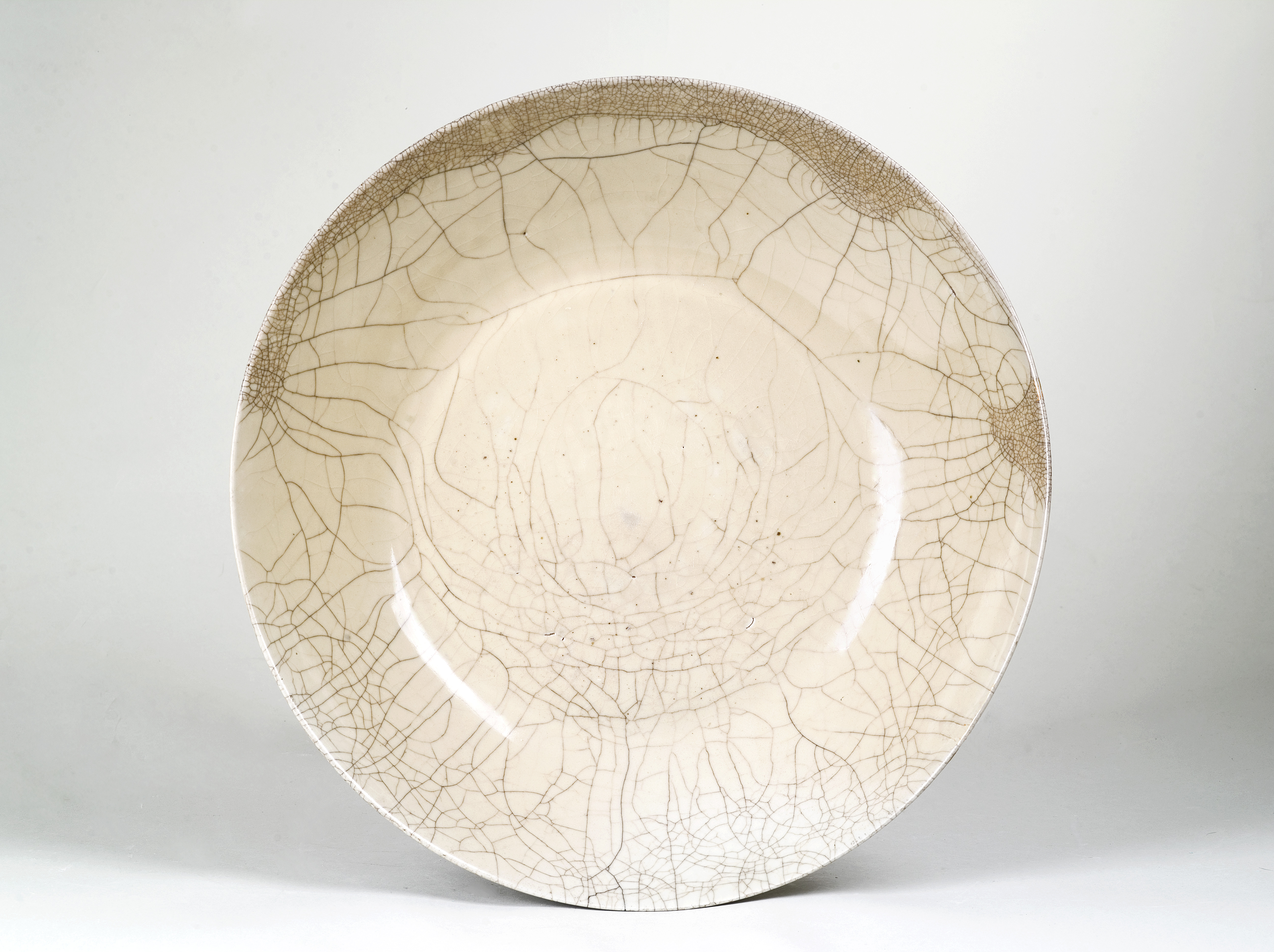
Fig. 6: Dish with white crackled glaze, Zhangzhou (China), c. 1600, porcelain, d. 48.5 cm
Leeuwarden, Princessehof National Museum of Ceramics, GRV 1940-029
photo: Johan van der Veer
During the time Verbeek and Van der Meulen started collecting, Chinese ceramics were – once again – in popular demand in Europe. The difference to earlier periods was, apart from a renewed interest in seventeenth and eighteenth century export porcelain for the West, a focus on ceramics from earlier periods catering to the Chinese market, including imperial pieces. The forced opening of China and the looting of the Summer Palace in 1860 resulted in these pieces entering the market, creating renewed interest by European and American collectors. What is notable about the Verbeek and Van der Meulen collections is that their pieces did not so much represent Chinese taste rather than an appeal to the different cultures in Southeast Asia. Verbeek also mentions in one of his articles that little was known about Chinese porcelain from the time before the West started trading in Asia and that there was even less awareness that these early pieces were to be found in such large numbers in Indonesia.41 Did both focus intentionally on collecting these early wares or was it a result of what they could get their hands on? As Ter Keurs pointed out:
Although collectors do not always openly report all the relevant facts in their writings (not even in their personal notes), there is ample evidence that political circumstance, manipulations of local sellers and middlemen had a big influence on the collecting practices. Western collectors were strangers in the countries where they operated, so they needed at least some local support.42
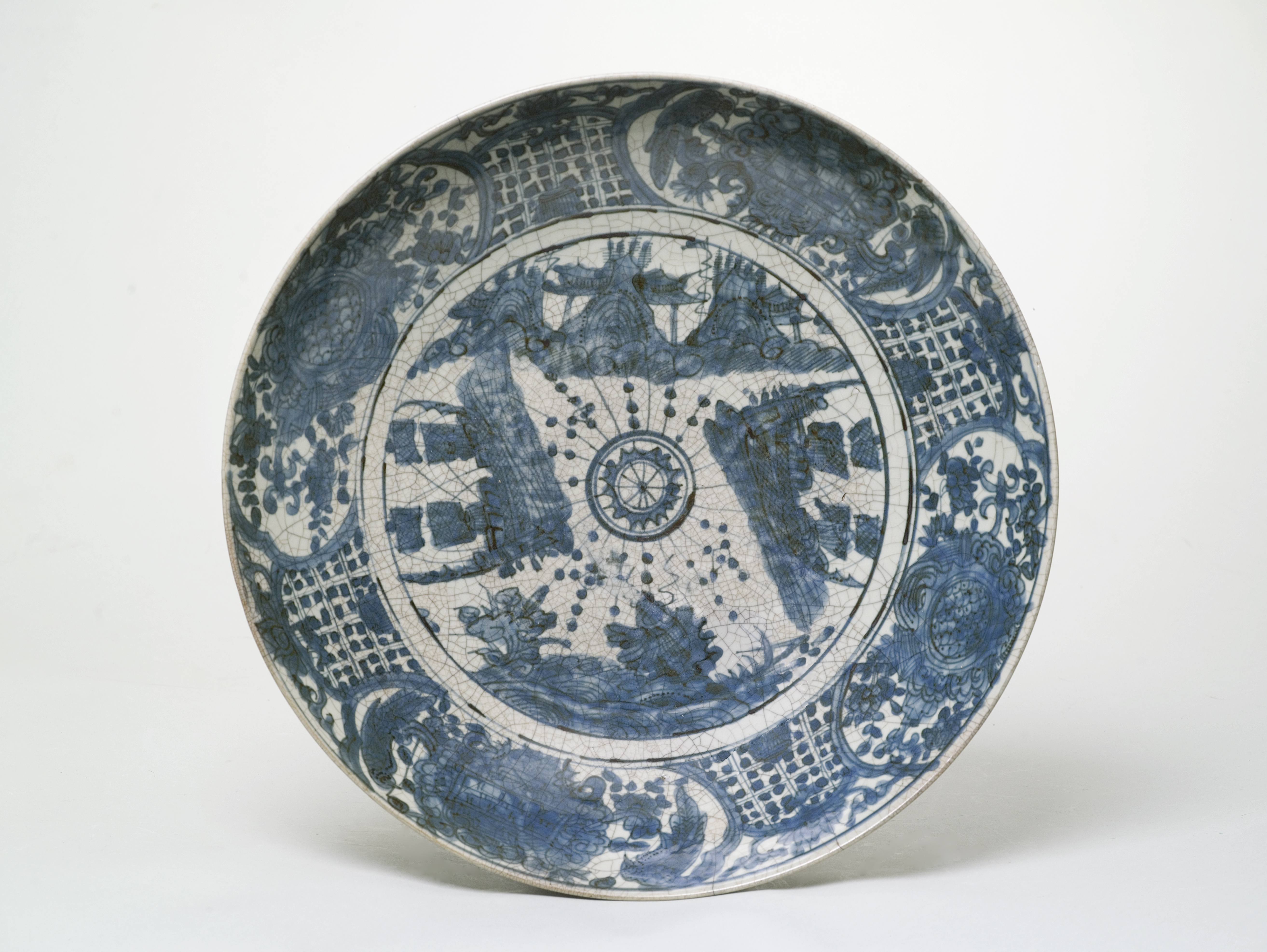
Fig. 7: Dish with landscape, South-China, porcelain c. 1600, porcelain and cobalt blue pigment under glaze, d. 45 cm
Leeuwarden, Princessehof National Museum of Ceramics, GRV 1926-016
photo: Johan van der Veer
This must have also applied to the collectors discussed here, especially in the early years of their activities. It is, however, very likely that as they became more interested in the material they collected, they also increasingly sought specific types of ceramics to add to their collection. Especially the large amount of Zhangzhou dishes in Verbeek’s collection seems to confirm this, even though his assessment as examples of early Chinese ceramics was erroneous.
The difference between Verbeek and Van der Meulen seems to be that the latter was trying to put together a representative collection of local cultures, as is evident by the many other objects he collected, the name of his museum and the way the objects were displayed and the classes received by his local teacher Mas Boediardjo. It appears that he regarded the Asian ceramics in his collection primarily as part of the local heritage of different cultures in Indonesia and less as examples from a certain period or a particular production centre of ceramics in China. Van der Meulen focussed on the use and meaning of those objects within that particular context. He was intrigued by the richness of the material culture present in Indonesia and curious to find out more about what these objects represented and how they had ended up there. Verbeek on the other hand wanted to build up a chronological study collection of Chinese ceramics. Taking into account his publications on Chinese ceramics, he seems to have had a lesser interest in the local cultures these objects were once part of. His initial choice to give his collection on loan to two museums that presented their collections as pieces of art instead of material culture seems to further confirm this focus. Both however must have been attracted by the idea of assembling a collection that would make them noticed among other European collectors at the time.
Van der Meulen and Verbeek, although at first glance two very different collectors, were products of their time. They started collecting in a period when the Dutch East Indies became increasingly absorbed into Dutch nation-building, and Indonesian cultural and material heritage were appropriated by the Dutch into their private collections and museums. In this article their collecting histories served as primary examples to ascertain why and moreover how Asian ceramics were acquired in Indonesia. There are many similar collecting histories to be told in relation to the Princessehof Museum, for example with regard to Hendrik R.A. Muller (1903-1979) and Anna Resink-Wilkens (1880-1945).
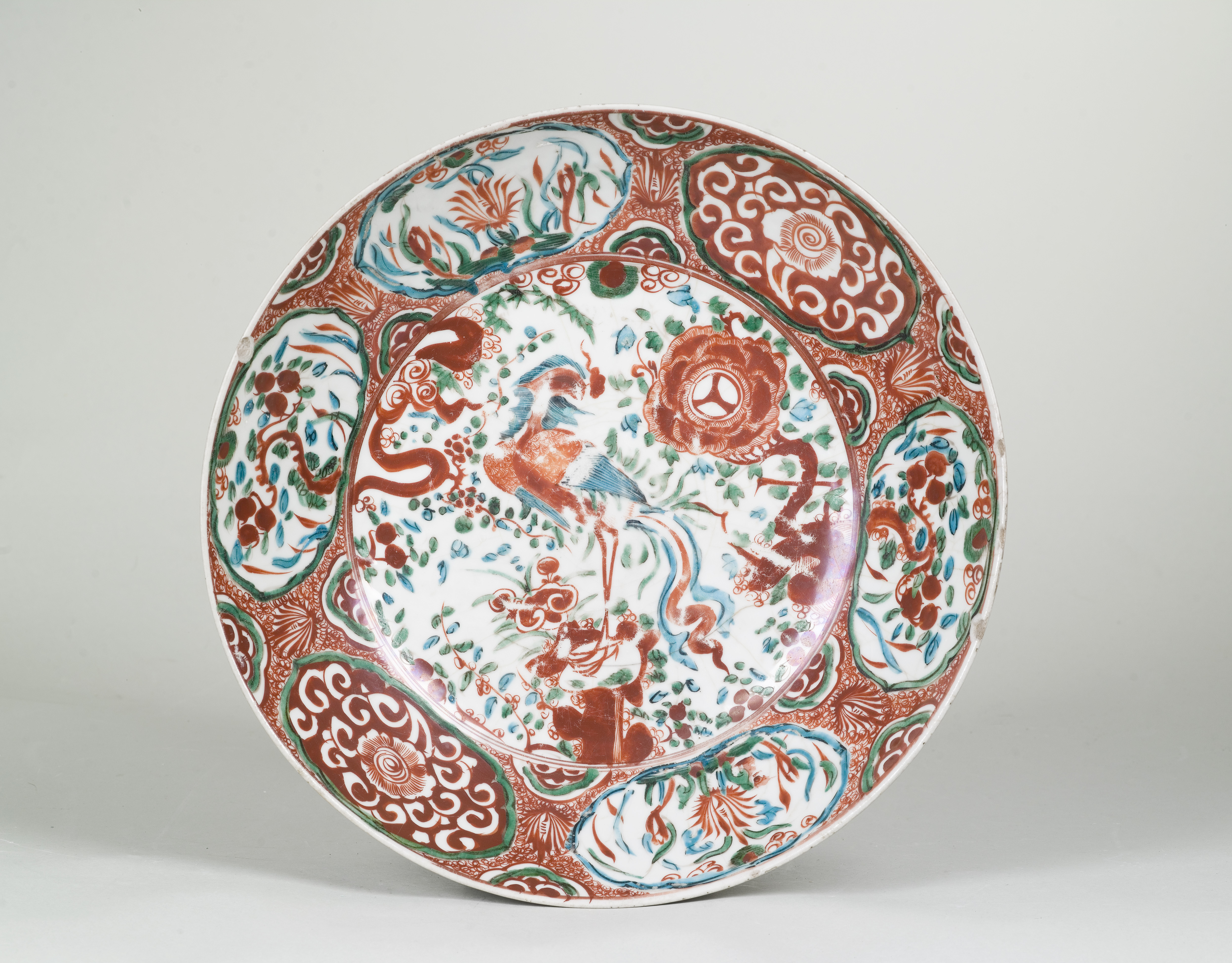
Fig. 8. Dish with phoenix design, South-China, c. 1600, porcelain, d. 37.5 cm
Leeuwarden, Princessehof National Museum of Ceramics, GRV 1929-060
photo: Johan van der Veer
In the Netherlands the discussion on the provenance and formation of public collections has become very active in recent years. Previously such research predominantly concerned war booty or objects found to be looted from historical sites.43 This area of research is now widening its focus to objects whose provenance history is more complicated to trace, including Asian ceramics. As shown by the examples of Van der Meulen and Verbeek, we are frequently unaware where exactly these objects were taken from; this provenance information is generally not recorded in detail and will most probably be impossible to trace. These objects were produced in large numbers and have no particular features that link them to any tribe or group specifically. So besides doing research, how can a public institution deal with this material? For museums it would be proper to be transparent about this history, since it is part of the cultural biography of an object that could also be of interest to the museum visitor. This can partly be achieved by listing such information on the online database available to the general public. In addition it is sensible to integrate this topic within the permanent display. By being open about these issues museums can create a platform for discussion and place the ownership and collecting histories of objects within the context of their time. Such an approach does justice to the long histories attached to the objects and to the different groups of people they once belonged to. It will show visitors the multiple ways in which an object can be appreciated, and that from the moment of its creation a journey begins that continues to this day.
Eline van den Berg is curator for Asian ceramics at the Princessehof National Museum of Ceramics in Leeuwarden.
1 The Princessehof Museum was established in 1917 in the former residence of Marie Luise of Hesse-Kassel (1688-1765). After her death the building continued to be referred to as “the Princess’ court”.
2 Nanne Ottema, De praktijk van het porceleinverzamelen: handboek voor verzamelaars van Chinees porcelein (Amsterdam, J.H. de Bussy, 1953), 159.
3 This will be a collaborative research project between the Rijksmuseum (RM), the National Museum of World Cultures (NMWW) and the Expertise Centre for Restitution at the NIOD Institute for War, Holocaust and Genocide Studieshttps://www.rijksoverheid.nl/ministeries/ministerie-van-onderwijs-cultuur-en-wetenschap/documenten/kamerstukken/2019/04/10/kamerbrief-met-reactie-op-artikel-over-roofkunst, last accessed on 05 August 2020.
4 The collection of Chinese ceramics consists of circa 6,000 pieces of which approximately one quarter has a provenance from Indonesia.
5 For comprehensive studies on this topic see for example Caroline A. Drieënhuizen, Koloniale collecties, Nederlands aanzien: de Europese elite van Nederlands-Indië belicht door haar verzamelingen, 1811-1957 (University of Amsterdam, 2012), https://pure.uva.nl/ws/files/1090540/105965_thesis.pdf, and Tular Sudarmadi, Between colonial legacies and grassroots movements: exploring cultural heritage practice in the Ngadha and Manggarai Region of Flores (University of Amsterdam, 2014), https://research.vu.nl/ws/portalfiles/portal/42127428/complete+dissertation.pdf; also Jos van Beurden, Treasures in Trusted Hand Negotiating the future of colonial cultural objects (Leiden, Sidestones, 2016) https://www.sidestone.com/books/treasures-in-trusted-hands, all last accessed on 20 April 2020.
6 Initially it was set up as a branch of the Hollandsche Maatschappij der Wetenschappen (Holland Society of Sciences) focussing on economics and science. Its activities soon expanded to also include the study of art and material culture of indigenous people. In 1778 this branch became independent and was renamed “Bataviaasch Genootschap van Kunsten en Wetenschappen” (The Batavia Society for Arts and Sciences).
7 This eventually became the present National Museum based in Jakarta. In the field labelled “collected’” several ways in which an object was acquired can be differentiated: presented as a gift, acquired during military or private expeditions (e.g. taken from historical sites), bought from local dealers or acquired directly from local families through middlemen.
8 Sudarmadi, Between colonial legacies, 54-56, Drieënhuizen, Koloniale collecties, 110.
9 Drieënhuizen, Koloniale collecties, 18, 305. Pieter ter Keurs, Collecting in the Colony, in Indonesia and the Malay World, 37/108 (2009), 147-161.
10 For example the Java (1825-1830) and Atjeh wars (1873-1914). The confiscated objects were donated to the Batavian Museum in Indonesia and museums in the Netherlands and other countries in Europe, Drieënhuizen, Koloniale collecties, 18.
11 Many of these antique dealers were travelling to various places and went from door to door to sell their wares to European customers. They were known as langganans, see Drieënhuizen, 315.
12 See for example: Eva Ströber, Ming, Porcelain for a Globalised Trade (Stuttgart, Arnoldsche Art Publishers, 2013), 98-156, and Chinese Celadons and Southeast Asian Ceramic Society. Other Related Wares in Southeast Asia (Singapore, Arts Orientalis, 1979).
13 For an overview see https://en.unesco.org/silkroad/silk-road-themes/underwater-heritage, last accessed 17 August 2020. For more information on how these ceramics ended up as heirlooms see for example: Barbara Harrisson, Pusaka: Heirloom Jars of Borneo (Oxford, Oxford University Press, 1989).
14 Drieënhuizen, Koloniale collecties, 110.
15 Rob Nieuwenhuys, Oost-Indische spiegel. Wat Nederlandse schrijvers en dichters over Indonesië hebben geschreven vanaf de eerste jaren der Compagnie tot op heden (Amsterdam, Querido’s Uitgeverij, 1978), 275-276.
16 Orsoy de Flines arrived in Indonesia in 1913. Soon after his arrival he started to collect Asian ceramics. After the donation of his collection to the Batavian Society he became curator of the Batavian Museum and spent many years studying the collection. See: Arnoud Haag, Wen Ting-tiang, Egbert Willem van Orsoy de Flines, in Aziatische Kunst, 48/2 (2018), 62-69.
17 In contemporary research large storage jars made in China and Southeast Asia are generally referred to as martaban. This connotation started to become in use from the nineteenth century onwards assuming that many of these jars were transported from the Burmese port on the golf of Pegu. As pointed out by Brigitte Borel, the name is however slightly confusing, since historical literature from the sixteenth and seventeenth centuries mentioning martaban or martavanen specifically refers to jars produced in or near Martban (Mottoma) and not to the large jars produced in other regions in Asia. For a detailed discussion see Brigitte Borel, A True Martaban Jar A Burmese Ceramic Jar in the Ethnological Museum in Heidelberg, in Artibus Asiae 74/2 (2014), 257-297.
18 Egbert W. van Orsoy de Flines, Museum Puat Djakarta - Guide to the Ceramic Collection (Jakarta, P.T. Dian Rakjat, 1972/first edition 1949), 51. Actually Van Orsoy de Flines mentions “superstition dying out”, which indirectly informs us about his (and other Europeans’) opinion about these practices. The introduction of schools by Europeans must also have had an effect of educating the local population that such practices were obsolete, therefore actively hastening the disappearance of these beliefs.
19 During previous centuries pieces must have also been found by locals when farming their land, however in the period in question this land was often no longer owned by them but by the Dutch. Therefore pieces that were found became possessions of the latter and were either kept or sold to antique dealers.
20 Nanne Ottema, Gids voor de verzameling Chineesche en Japansche Ceramiek in het Princessehof te Leeuwarden (Leeuwarden, Princessehof, 1929), 4-5.
21 Caroline A. Drieënhuizen, Being “European” in Colonial Indonesia. Collectors and Collections between Yogyakarta, Berlin, Dresden and Vienna in the Late Nineteenth Century, in BMGN - Low Countries Historical Review, 134/3 (2019), 21–46.
22 Ter Keurs, Collecting in the Colony, 149.
23 Next to Asian ceramics the collection consists of other materials collected in Indonesia. This part is still housed in the Princessehof; however it is not regarded as the core of the museum collection and therefore not on display. For the scope of this article I only focus on the Asian ceramic collection gathered by Van der Meulen.
24 Anne Tjibbes van der Meulen, De Indische verzameling te Bergum. Hoe zij ontstond. Wat zij bevat (Bergum, De Motor, 1906), 3-4.
25 This collection of glass objects acquired in Egypt was donated by Van der Meulen to the Antiquities Museum in Leiden where it is still housed today, see Jill Hendriks, The Pasha of Glass – Travelling Collector Anne Tjibbes van der Meulen, National Museum of Antiquities (Leiden, Rijkmuseum van Oudheden, 2009).
26 Van der Meulen, De Indische verzameling, 7.
27 In Dutch: Controleur Binnenlands Bestuur.
28 J.E. Jasper, Ceramische Kunst in den Indischen Archipel, in Elseviers Geïllustreerd Maandschrift, 20 (Amsterdam, Elsevier, 1910) 383-384, https://www.dbnl.org/tekst/_els001191001_01/_els001191001_01_0107.php, last accessed 08 April 2020.
29 Van Orsoy de Flines, Museum Puat, 17.
30 Ibid., 50.
31 Nanne Ottema, Chinese keramiek (Lochem, De Tijdstroom, 1970), 73.
32 Nanne Ottema, Chineesche Ceramiek Handboek – Verzamelingen in het Museum het Princessehof te Leeuwarden (Amsterdam, J.H. De Bussy 1943), 123.
33 Fort de Kock was a fortification in Bukittinggi, West Sumatra.
34 Pieter J. Veth, Midden-Sumatra, reizen en onderzoekingen der Sumatra-expeditie: 1877-1879 (Leiden, Brill, 1881), 51.
35 J. van Campen, Japanese treasures from Sumatra’s West coast. Japanese porcelain from the Verbeek Collection in the Princessehof, Leeuwarden, in Andon 74 (Leiden, Society of Japanese Art, 2003), 8.
36 Letter from H. Miedema to Ir. J.D. Verbeek Bron, dated 4 December 1957, Princessehof archives, no archival reference.
37 Reinier Verbeek, Oud Chineesch porcelein in Nederlandsch-Indië uit de tijden der Soung en Ming dynastieën, in Nederlandsch-Indië, oud en nieuw III (1918), 366, 208, 363, and Reinier Verbeek, Oud Chineesch porcelein in Nederlandsch-Indië uit de tijden der Ming-dinastie (1368-1643), in Nederlandsch-Indië, oud en nieuw VII (1922), 48.
38 Inventory no. GRV 1940-029; Ottema, Chineesche Keramiek Handboek, 139.
39 B.J. van Tent, Nieuws van het Princessehof, in Antiek (Lochem, De Tijdstroom, 1980) 15/ 4, 230
40 In the current display at the Princessehof this room no longer exists. Various pieces from Verbeek’s collection are dispersed among the permanent exhibition in the museum.
41 Verbeek, Oud Chineesch porcelein, 111.
42 Pieter ter Keurs, Museums between Enlightenment and Romanticism, in UMAC Journal (UMAC, 2010), 11-20.
43 In several cases this has also resulted in some relics to be returned, either by museums or the descendants of the Dutch person who initially owned the objects, for example part of the Lombok Treasure in 1978 and Diponegoro’s pilgrim’s staff in 2015.